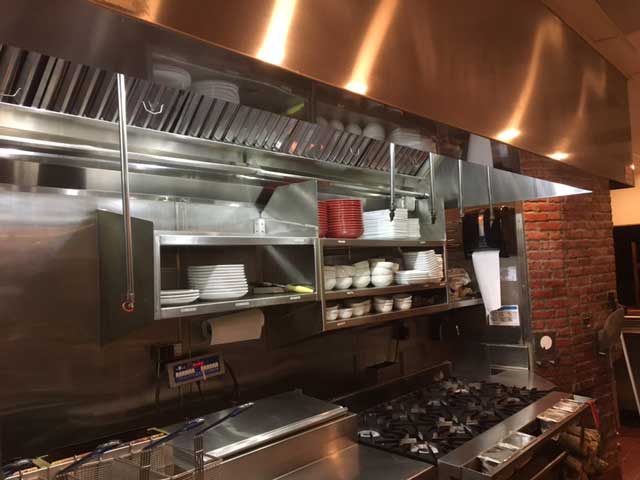Transformation into Order: Examining the Efficiency Gain Achied through Proper Hood Cleaning in a San Jose Kitchen
Welcome to this case study that investigates the remarkable impact of proper hood cleaning in a San Jose kitchen. In food service, keeping an orderly kitchen is of utmost importance, and an essential component of kitchen ventilation system – its hood – plays a pivotal role in creating an orderly environment that promotes productivity. In this case study, we explore its remarkable effects and explore its transformative powers within an American kitchen environment.
An Importance of a Clean Hood
A clean hood is more than an aesthetic choice; it is an integral component of maintaining the overall efficiency and safety of any kitchen. By eliminating grease, smoke, and odors that contribute to unhealthy working environments and fire hazards while prolonging equipment lifespan; additionally it improves ventilation system functionality so as to allow its optimal performance.

Before embarking on the journey of turning chaos into order, it is essential to identify any signs that point towards an ineffective kitchen caused by an unclean hood. Here are some indicators:
Grease build-up on surfaces one telltale sign of neglectful home care is grease build-up on countertops, walls and appliances – not only is this unpleasant but it attracts pests and compromises food safety as well.
Poor Air Quality
An unclean hood may fail to effectively extract smoke, steam and airborne contaminants from the kitchen environment, creating poor air quality for kitchen staff and creating discomfort or health risks for themselves and visitors. This can have serious repercussions both physically and psychologically.
An Ineffective Ventilation Solution
Clogged hoods restrict proper airflow and ventilation, leading to ineffective ventilation that results in an uncomfortable working environment with excess heat and the persistent smell of food.
Increased Fire Hazards Grease accumulation within the hood and ductwork exponentially increases the risk of fire, as its highly combustible nature makes it highly flammable and easily ignites, endangering both kitchen workers and their occupants.

After we have identified the mess, it’s time to unleash the transformative potential of regular hood cleaning and maintenance. With an efficient kitchen come many advantages that come with proper hood care – here are just a few:
Increased Fire Safety
Regular hood cleaning removes built up grease, and significantly decreases the risk of fire. By eliminating potentially flammable substances from accumulating within, proper cleaning provides a safe working environment for kitchen staff.
Improve Indoor Air Quality
A ventilation system equipped with a clean hood can efficiently extract smoke, steam and airborne contaminants – improving overall indoor air quality while creating a healthier workspace environment.
Clean Hood for Maximum Equipment Performance
A clean hood ensures the ventilation system runs at peak performance by clearing away debris such as grease or other obstructions, increasing airflow through the system and prolonging equipment lifespan.
Compliance With Health and Safety Regulations Adherence to local authorities’ regulations on hood cleaning is necessary in order to meet health and safety regulations set by local governments, and for kitchen operators and owners. By complying with such standards, penalties can be avoided as well as maintain an excellent reputation in their market place.

Increased Efficiency and Productivity
A clean and organized kitchen allows staff to work more efficiently, leading to increased productivity. By eliminating distractions and creating a safer working environment, employees are freed up to focus on their tasks with greater ease, creating smoother operations and improved customer service.
Below are frequently Asked Questions (FAQs).
Q: When should a hood be cleaned?
A: Cleaning frequency depends on several factors, including cooking volume and type as well as local regulations. As a general guideline, at least every three to six months.
Q: Can I clean the hood myself?
A: While basic maintenance, such as surface cleaning, may be accomplished by kitchen staff, professional hood cleaning should always be handled by certified technicians with experience and knowledge in ensuring compliance and optimal performance of hood systems.
Q: Are There Any Risks Involved With Hood Cleaning?
A: Hood cleaning requires working with potentially hazardous substances and equipment, so hiring trained professionals who adhere to safety protocols in order to mitigate risks and ensure an efficient cleaning process.
Q: Will a dirty hood have an effect on the taste and quality of food?
A: Absolutely, as accumulations of grease and odors in the kitchen area can have a devastating impact on flavor creation. Proper hood cleaning helps ensure food integrity is preserved.
Q: Where can I find a reliable hood cleaning service?
A: To locate a trustworthy hood cleaning service, seek recommendations from food industry colleagues as well as certified and insured professionals with a history of providing high quality service.
Q: What are some indicators of immediate hood cleaning?
A: Signs indicating immediate hood cleaning include excessive smoke while cooking, visible grease build-up on hood surfaces, and persistent foul odor in the kitchen. If any of these occur it is imperative that a professional cleaning service be scheduled immediately for servicing.
Conclusion
Establishing order from chaos is key to maintaining an efficient and safe kitchen environment. Our case study of proper hood cleaning in a San Jose kitchen illustrated this point well; by prioritizing cleanliness and maintenance we witnessed its significant efficiency boost. By investing in routine hood cleanings businesses can increase fire safety, indoor air quality, equipment performance optimization, regulatory compliance assurances and overall efficiency and productivity gains – don’t allow chaos reign in your kitchen- take steps today to transform it into an efficient workspace!







